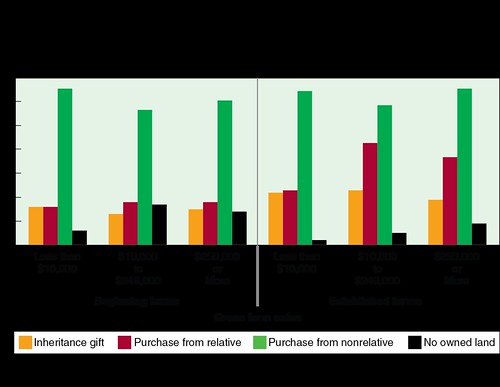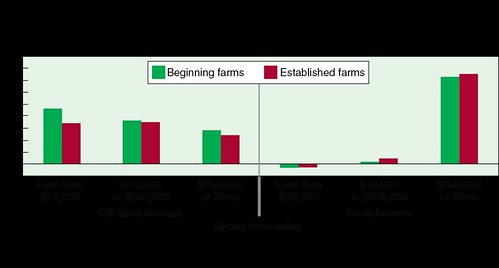USDA programs have targeted assistance to beginning farmers and ranchers since the 1992 Agricultural Credit Improvement Act. Farms or ranches are considered “beginning” if the operators have managed them for 10 years or less. The Economic Research Service has looked at the trend in numbers of beginning farmers and ranchers in recent decades and examined some key characteristics that distinguish them from established farms using the Census of Agriculture and the Agricultural Resource Management Survey. Taken every five years, the Census provides the only source of uniform, comprehensive and impartial agricultural data for every county in the nation.
For more than two decades, the share of farms operated by beginning farmers has been in decline. Beginning farms and ranches accounted for 22 percent of the nation’s 2 million family farms and ranches in 2011 – down from about 38 percent in 1982. Consistent with this trend, the average age of principal farm operators in the United States has risen in that period, from 50 to 58.
As beginning farms are smaller on average than established farms, they account for only 10 percent of production on family farms. Beginning farmers often report that their biggest challenge in getting started in farming is access to enough capital and farmland to operate at a size capable of earning a sufficient profit. Not surprisingly, the households of beginning farm operators have lower farm and nonfarm net worth than the households of established farms.
While most beginning farms include some operator-owned land, they are more likely than established farms to have only rented land. For U.S. farmers in general, the most common way to have acquired “owned land” for their operation is to have purchased it from a nonrelative. But established farms of all size classes are more likely than beginning farms to have inherited or purchased their owned land from relatives.

Most U.S. farm households—whether beginning or established—have for decades received a majority of their household income from off-farm sources. For beginning farm households, average farm income is less than that for established farm households, but their off-farm income is higher on average than that of established farm households. This difference holds, regardless of farm size.

Operators and spouses on beginning farms are even more likely than their counterparts on established farms to work at off-farm jobs and businesses, and are also more likely to have a college degree. Off-farm income can enable beginning farmers and spouses to meet living expenses and/or to expand farm operations if their long-term goal is to farm full time.
Our new report, Beginning Farmers and Ranchers at a Glance, also compares beginning farms and ranches with established enterprises by other characteristics, including commodity specialties, participation in government programs, and value of production. (Additional information on beginning farmers and ranchers can be found on the ERS website.)
USDA’s 2012 Census of Agriculture and the Department’s Agricultural Resource Management Survey (ARMS), both currently underway, will yield updated data on these and other farms. We encourage beginning farmers and ranchers to participate in the Census and in ARMS, in order to be counted and in order for policy makers and program administrators to have an accurate picture of these farms.


